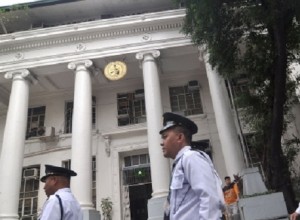
Baraan told the Philippine Daily Inquirer at the sidelines of the Human Rights and Legal Assistance forum – which was attended by lawyers and human rights advocates on Tuesday — that he found this out after having been informed about a suspect who had been arrested and released thrice.
He said the case showed that government prosecutors have been using the same “old school method in conducting investigation and prosecution.”
“Others simply focus on (the aspect of) prosecution by coming up with a resolution without making sure it is fair and just,” he said.
Baraan said a review of the cases would enable the Department of Justice (DOJ) to determine which ones were filed using the “bahala na (‘whatever comes next’ or ‘come what may’)” system.
“I see the need to review all the cases of the Abu Sayyaf suspects arrested and in jail. What struck me is that there is even one case, one person arrested thrice and he was released thrice,” he said.
Baraan said the sheer number of cases lodged in various courts in Western Mindanao, the Autonomous Region in Muslim Mindanao and even Metro Manila was overwhelming.
“But I have yet to see the databank or profiles of the cases. I am very interested in getting and gathering all the cases and background of all the accused, their names, circumstances and the manner how they were arrested and where these people are now,” he said.
Laisa Alamia of the Commission on Human Rights in the ARMM said he agreed with Baraan and that the case of 39-year old motorcycle driver Hussein Ahadin of Zamboanga City should be enough to set off the alarm on how the government’s anti-terror campaign was being carried out.
Ahaddin is the man that Baraan had referred to as the suspect who was thrice arrested, thrice released.
“I don’t think a guilty person would think of going back to his home and be a subject of repeated arrest,” Alamia said.
Ahaddin was initially charged for the Oct. 2, 2002 explosion in Upper Calarian, Malagutay, where US soldier Sergeant First Class Mark Wayne Jackson was killed; and the Oct. 17, 2002 twin bombings of the Shoppers Department Store in Zamboanga, where more 60 people were hurt.
Ahaddin was detained for a month and was released after his family submitted proof he was arrested on a mistaken identity.
But in August 2007, he was again arrested but was released when his human rights workers and his family secured a writ of habeas corpus.
On November 30, 2011, Ahaddin was arrested anew for the October 11, 2011 bombings of the Red Palm Inn in Guiwan, Zamboanga City and the San Roque cockpit; and the October 26, 2011 explosion in Sangali District, also in the same city; and the November 27, 2011 explosion at the Atilano Pension House.
He was released again after his family questioned the warrant of arrest.
Ahaddin said he could not understand why authorities insisted that he was Muksin Ajijul Ahaddin, an alleged notorious Abu Sayyaf bomber.
Zamboanga City Prosecutor Ricardo Cabaron said Ahaddin’s arrest was backed by witnesses’ accounts.
Edil Baddiri, a lawyer and a commissioner of the National Commission on Muslim Filipinos, said countless arrests have been made in Mindanao without the police giving the suspects the benefit of the doubt and the constitutional presumption of innocence.
Baddiri said this was the same reason human rights forums – such as the one’s the NCMF hosted – have become important.
“It is a disgrace for me if we cannot do something about it. It is the NCMF mandate to provide legal assistance and it’s a disgrace for us if we cannot even give attention to all these injustices…,” he said.
Lawyer Galuasch Ballaho, deputy executive director of the Mindanao Human Rights Action Center, said almost three fourths of those arrested on suspicion of being Abu Sayyaf members had turned out to be innocent of the charges.
He said those who were innocent could not challenge their arrest because they had nobody to run to. “They don’t have the means (to prove their innocence) and most of them are not educated,” Ballaho said.
Former Lantawan, Basilan mayor Tahira Ismael said the arrests made in the aftermath of the July 2011 mass hostage-taking at the Golden Harvest Plantation in Barangay (village) Tairan in Lantawan, were clear examples of human rights violations.
“Not all of those arrested and brought to Zamboanga City or Manila were involved. I should know because I knew them from our childhood years,” Ismael said.
But Ismael said officials like her could not do anything because arresting officers always had witnesses.
Ismael suspected that most of the witnesses were “manufactured witnesses for the love of bounty.”